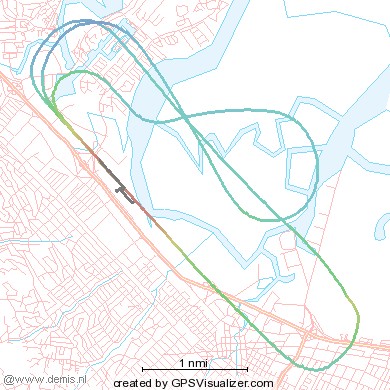|
One thing I love about text chat in instant messengers is I can carry
on two simultaneous conversation threads with a person at the same
time. I write something on topic A, and while waiting for my friend to
respond I say something about topic B. When he's done responding to
topic A and waiting for me, he can start talking about topic B. Back
and forth, ABABAB. Two conversations interwoven, very natural.
Flying airplanes is hard, but pilots do learn to fly planes safely. How do we manage all the complexity? By managing our attention, by using checklists, and by taking advantage of simplifying technologies. Some of these techniques are applicable to other complex tasks, like cooking or software engineering.
Attention training. Practice makes seemingly impossible tasks easier. When I first started flying it took all my attention to keep the plane level. I literally could not handle the radio interruptions. Now that basic flying comes naturally I have plenty of spare attention to talk on the radio. Except when I'm very busy; I've learned to ignore the radio if I don't have time for it. Training has developed my attention capacity and taught me to manage distractions. Checklists. There's some 35 steps I do to get a plane ready to fly. Fortunately I don't have to memorize them all, because I have a checklist that I follow every single time I start a flight. If I follow that checklist I'm fine. If I forget a step the plane won't start, or my gyro compass will be off a few degrees, or the flaps will be set wrong and I'll stall on takeoff and die. I'll be using my checklist every single flight for the rest of my flying career. Checklists are broadly applicable to many areas. I once wrote a two page checklist for a server deploy at Google and it paid off in spades for years afterwards. Autopilot. I'm not using an autopilot during my training, but even the simplest one that does nothing but keep the wings level makes flying a lot easier. Ken's about to get a fancy autopilot that can literally fly an entire course for you, including instrument approaches, from about 400 feet after takeoff to 400 feet from landing. Of course you never want to fully trust the robot with the flight, but it's a big help to offload the basic control inputs so you have more attention for more complex things. GPS navigation. Moving map GPS is a huge user interface improvement for navigation. No more trying to spot landmarks from the air or figure out your position via triangulation. You just punch in your destination, press "direct", and you've got a flight plan. A GPS with a terrain database helps you avoid hitting mountains. Add a synthetic vision system and you don't even need to be able to see out the window. Unfortunately very little modern flight training uses the GPS, it's going to take a generation for common practice to change. Writing software used to seem very difficult. But over the years I've learned how to code and the technology for writing software has improved. Garbage collection is like autopilot for memory management, modern IDEs are like GPS maps for visualizing code. Unfortunately the pace of technology development in aviation is very slow compared to software engineering because of all the testing and certification required. But there's more opportunities for improvement via training and plenty of checklists.
I'm at the point flying now where I'm fine if things go as planned. But I don't have much experience improvising. Today's solo flight was a good exercise.
 The first complication happened on my downwind. I was following another Cessna around the pattern, cleared to land #2. And following, and following. Normally you turn base at about half a mile or so past the runway. I was more than a mile and a half out still following this guy on downwind when the tower called to remind me I was #2 to land, implicitly asking why I hadn't turned yet. I quickly reported "following traffic still on downwind". That must have woken the other pilot up, he started to turn. I was all out of my usual routine trying to figure out what power and flaps I needed for this greatly extended pattern. Rule #1: fly the plane. I took stock and realized I was way too slow, so I pitched down, added some power and made my turn behind the other plane. I just about had this unusual approach figured out when I realized the plane I was following was staying high like he was going to overfly the field. Then the second complication: he did a forward slip, dropped swiftly, and landed. And kept rolling down the runway, leisurely using the full length of the field. And me coming in as slow as I dared hoping to land behind him. Tower asked the guy to expedite getting off the runway, he casually replied he'd turn when he could. When I was about 20 feet from touching down the guy was still on the runway so tower told me to go around. Unexpected, but not dangerous. In the meantime I'm hearing pilots ask for updated winds and now they're 140@9kts. The third complication: the wind had swung around and was getting strong enough to be uncomfortable. Tower mentioned considering switching runways but had five planes in the pattern. Soon they were telling everyone to land and wait, clearing the air. Meantime I'm still up there, seemingly forgotten, and with no idea where the other planes were. So I called in "Tower, am I cleared to turn base?". Our tower guys at KSQL are great. He immediately told me to turn left 180 and enter left downwind for the other runway. So I made my turn, watching very carefully for planes, and proceeded to make a very ordinary approach. Except the ground was going by very fast on short final, the wind had swung around again and I ended up landing with a bit of a tailwind. That was enough adventure for one day, so I called in to taxi to parking. I'm a bit proud that Tower replied with a "thanks for the help". Guess I got it right!
Update: I heard from someone else that the plane
ahead of me on downwind had been told to extend downwind by tower. I
must have missed that. Also they were in a slower plane than I, which
may explain why I overtook them on final.
When I started learning to fly it seemed impossibly difficult. Flying seems easier now, although still challenging. It's roughly the same kind of skill as driving a car and no one thinks back on learning to drive as particularly difficult. But it only takes 6-10 hours of driving time to get a car license, compared to 40-70 hours of flying time for a pilot's license. Why is flying so much harder?
Control complexity. Cars only steer in one dimension; planes steer in two. Even a level turn is hard in a plane, you have to coordinate two controls, except sometimes you deliberately uncoordinate them. Managing engine power is harder in a plane: two or three controls in a piston, not just a single pedal. And then there's auxiliary controls you have to use occasionally: flaps, carburetor heat, fuel tank selector, etc. Even starting a plane requires carefully using four controls in the proper relationship. Being in the air. Planes at altitude have a lot of potential energy. A primary challenge of landing a plane is learning how to bleed that energy off to make a soft landing. In a car you just brake. And if something goes wrong in your car you can pull over to the shoulder and stop; that doesn't work so well in a plane. So there's hours of learning how to get a plane safely down in various kinds of emergencies and equipment failures. Also learning to ensure you can land: running out of gas or flying in to clouds are dangerous, so there's a lot of training to avoid those situations. Instruments. Operating a modern car is pretty easy, you don't think about the engine unless an idiot light comes on. Flying requires a lot more vigilance. You're constantly watching your heading, airspeed, altitude, attitude, and engine power to make sure you're flying roughly right. And there's a bunch of extra instruments you need to scan regularly; oil pressure, outside temperature, voltages, etc. It only gets more complicated if you're flying when you can't see, that's a whole 'nother 55+ hours of training. Communication. Most general aviation flights are constantly on the radio, talking to ATC to get permission to takeoff and land, to get separation from other aircraft, or simply to be followed for safety. We know talking on a cell phone while driving is remarkably distracting. It's not quite as chatty in a plane, but it's necessary communication and it has its own special language. Learning to work the radio was remarkably difficult for me and it's still a constant distraction. Navigation. In a car you just follow the road and signs, maybe look at a map or a GPS to make sure you make a turn. In a plane you're largely on your own in three dimensions. If it's good weather it's not too hard to avoid mountains, but some of the obstacles are invisible. And while moving map GPS has revolutionized GA navigation, I still have to learn to fly without it: dead reckoning, pilotage (aka "looking down"), flying between radio beacons. And even if you know which way to fly, you still have to calculate for invisible winds. The good news about pilot training is it seems impossibly difficult at first but gets easier with training. In a followup blog post I'll talk about some of the ways pilots manage complexity. But no matter how skilled the pilot or how many good tools they have, flying always remains a complex activity requiring attention, thoroughness, and constant practice.
I'm doing some geographic hacking. I get confused about degrees, seconds, fractions,
and precision of coordinates. Here's some approximations for how far distances are for latitude
degrees. Imperial measures, my apologies to my non-American friends who are not crippled
by years of non-metric education.
Those numbers are for latitude. Longitudes get narrower at the poles. At San Francisco's latitude of 37 degrees, a degree of longitude is about 55 miles, or about 80% of a degree of latitude. A modern consumer GPS with WAAS should be accurate to within about 15 feet. So for many contemporary geocoding applications, you want to record and publish numbers to about 0.1 seconds or 0.00001 degrees. That's 26 bits of precision, which fits comfortably in a fixed-width 32 bit number but is too precise for a 32 bit IEEE float.
Calculations thanks to
this Javascript library
|
||||||||||||||||||||

